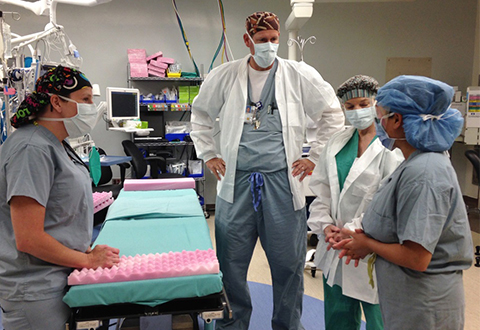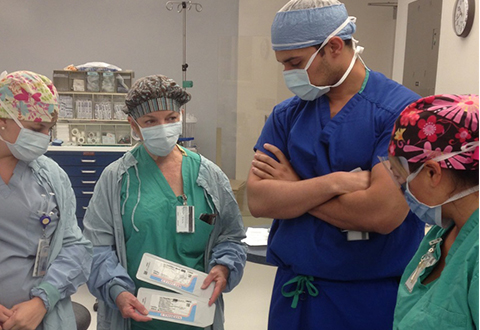Shreveport: A Success Story

A pre-procedure briefing with the surgical team helps to identify problems early on and prevents surgical errors. From left: Kristy Kraker, surgical technician, CRNA; Ellis “Bubba” Maxwell; Barbara Fanta, circulating nurse; SreyRam Kuy, surgeon
At the Overton Brooks VA Medical Center, we have made a concerted effort over the past year to not just improve, but excel at being a safe and high-quality surgical service. As a result, we have made tremendous strides in changing the culture of our surgical service. A year ago, we embarked on this journey, starting with a Clinical Team Training (CTT) session led by Douglas Paull, M.D., director of NCPS’ patient safety curriculum and medical simulation program.
“The Overton Brooks surgical service story demonstrates that patient safety can serve as a rallying theme to provide joy, meaning and success in our daily work in caring for Veterans,” said Dr. Paull. “The story has heroes, including transformational leaders and staff who embraced change and implemented a new framework, Crew Resource Management – CRM – to improve teamwork and communication, staff morale, and patient outcomes.”

Pre-procedure briefings allow the team to identify needed supplies and answer questions, preventing delays and “wasted” minutes in the OR. From left: Stephani Bordelin Frost, CRNA student; Barbara Fanta, circulating nurse; Aras Emdadi, surgery resident; SreyRam Kuy, attending surgeon. Two team members present, but not in the photo: Joseph Zachary, chief surgery resident; Burt Smith, CRNA.
We came full circle when our second CTT session was held with Dr. Paull, June 18, 2014. Using both observational and survey data, via the Kirkpatrick Learning Model, we found that over the course of this past year our surgical service team members have significantly improved our communication skills, applying CRM principles and techniques to our daily work in the OR, as noted by Dr. Paull. Using a multi-pronged approach, we have implemented pre-procedure briefings, time-outs, post-procedure briefings, OR to PACU hand-offs (using a standardized template) and integrated situational awareness strategies/countermeasures into our culture. Learn More Read the entire article in the September/October edition of TIPS.



















